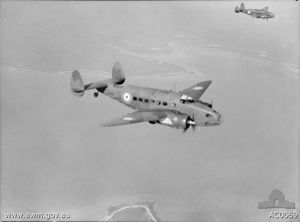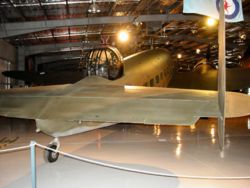PlaneSpottingWorld welcomes all new members! Please gives your ideas at the Terminal.
Lockheed Hudson
The Lockheed Hudson was an American-built light bomber and coastal reconnaissance aircraft built initially for the Royal Air Force shortly before the outbreak of the Second World War and primarily operated by the RAF thereafter. The Hudson was the first significant aircraft construction contract for the Lockheed Aircraft Corporation—the initial RAF order for 200 Hudsons far surpassed any previous order the company had received. The Hudson served throughout the war, mainly with Coastal Command but also in transport and training roles as well as delivering agents into occupied France.
Contents
Design and development
In 1938, the British sought an American maritime patrol aircraft to support the Avro Anson. On 10 December 1938, Lockheed demonstrated a modified version of the Lockheed Model 14 Super Electra commercial airliner as the Hudson Mk I, which swiftly went into production. By February 1939, Hudsons began to be delivered, initially equipping No. 224 Squadron RAF at Leuchars, Scotland in May 1939. By the start of the war in September, 78 Hudsons were in service.
A total of 350 Mk I and 20 Mk II Hudsons were supplied (the Mk II had different propellers). These had two fixed Browning machine guns in the nose and two more in a Boulton Paul dorsal turret. The Hudson Mk III added one ventral and two beam machine guns and replaced the 1,100 hp Wright Cyclone 9-cylinder radials with 1,200 hp versions (428 produced).
The Hudson Mk V (309 produced) and Mk VI (450 produced) were powered by the 1,200 hp Pratt & Whitney Twin Wasp 14-cylinder two-row radial. The RAF also obtained 380 Mk IIIA and 30 Mk IV Hudsons under the Lend-Lease programme.
Operational history
The Hudson achieved some significant feats during the war. On 8 October 1939, over Jutland, a Hudson became the first RAF aircraft to shoot down a German aircraft. (The accolade of the first British aircraft to shoot down a German plane went to the Blackburn Skua of the Fleet Air Arm on 26 September 1939.) They operated as fighters during the Battle of Dunkirk. A PBO-1 Hudson of USN squadron VP-82 became the first US aircraft to destroy a German submarine when it sank U-656 southwest of Newfoundland on 1 March 1942.
Hudsons were operated by RAF Special Duties squadrons for clandestine operations; No. 161 Squadron in Europe and No. 357 Squadron in Burma. They were used as patrol bombers in the Pacific war by the USN and also the RNZAF and RAAF. They also became the first plane to fire a shot in the Pacific Campaign by sinking a Japanese navy transport ship, the IJN Awajisan Maru, just off the coast of Kota Bharu, an hour before Pearl Harbour.
In 1941, the USAAF began operating the Hudson; the Twin Wasp-powered variant was designated the A-28 (82 acquired) and the Cyclone-powered variant was designated the A-29 (418 acquired). The US Navy operated 20 A-28s, redesignated the PBO-1. A further 300 were built as aircrew trainers, designated the AT-18.
A total of 2,584 Hudsons were built. They began to be withdrawn from frontline service in 1944.
The type formed the basis for development of the Lockheed Ventura.
Operators
- Template:AUS: RAAF
- Template:BRA: Brazilian Air Force
- Template:CAN: RCAF
- Template:China as ROC
- Template:IRE
- Template:NLD
- Template:NZL: RNZAF
- Template:POR
 South Africa: South African Air Force
South Africa: South African Air Force- Template:UK: RAF
- Template:USA: USAAF, US Navy
Survivors
Former Royal New Zealand Air Force Hudsons which saw service during the Second World War in the South Pacific are on display at the Royal New Zealand Air Force Museum and Ferrymead Heritage Park in Christchurch and the Museum of Transport and Technology in Auckland. A Hudson in Royal Australian Air Force colours is preserved in the Royal Air Force Museum at Hendon. RAAF Hudsons can be found at the Temora Aviation Museum [1], the Australian War Memorial and the RAAF Museum. Other ex-RNZAF and RAAF machines are in private hands. One aircraft, in Australia, was converted for passenger use and flown by East West Airlines. One complete and several partial Hudsons also exist in Canada. A Lockheed Hudson Mk IIIA (T9422) after years mounted on a pedestal near Washington Street, is on outdoor display at the North Atlantic Aviation Museum, Gander, Newfoundland, Canada.
Popular culture
- The Lockheed Hudson features prominently in the Captains of the Clouds (1942). The film starred James Cagney and Dennis Morgan as Canadian bush pilots who do their part in the Second World War as ferry pilots, bringing Hudsons to Britain.
- Above and Beyond (2006) Canadian Broadcasting Corporation (CBC) four-hour mini series was inspired by the true story of the Atlantic Ferry Organization, recounting the daring plan to deliver aircraft across the North Atlantic to the beleaguered Royal Air Force. The Lockheed Hudson is the primary aircraft portrayed in the mini series in the form of a real life example and numerous CGI Hudsons. [2]
Specifications (Hudson Mk I)
General characteristics
- Crew: 6
- Length: 44 ft 4 in (13.51 m)
- Wingspan: 65 ft 6 in (19.96 m)
- Height: 11 ft 10 in (3.62 m)
- Wing area: 551 ft² (51.2 m²)
- Empty weight: 12,000 lb (5,400 kg)
- Loaded weight: 17,500 lb (7,930 kg)
- Max takeoff weight: 18,500 lb (8,390 kg)
- Powerplant: 2× Wright Cyclone 9-cylinder radial engines, 1,100 hp (820 kW) each
Performance
- Maximum speed: 218 kt (246 mph, 397 km/h)
- Range: 1,700 nm (1,960 mi, 3,150 km)
- Service ceiling: 24,500 ft (7,470 m)
- Rate of climb: 1,200 ft/min (6.2 m/s)
- Wing loading: lb/ft² (kg/m²)
- Power/mass: hp/lb (kW/kg)
Armament
- Guns: 4× .303 in (7.7 mm) Browning machine guns
- 2× in nose
- 2× in dorsal turret
- Bombs: 750 lb (340 kg) of bombs or depth charges
Related content
Related development
Comparable aircraft
Designation sequence
- A-25 - A-26 - A-27 - A-28 - A-29 - A-30 - A-31 - A-32
- U.S. Army sequence: C-53 - C-54 - C-55 - C-56 - C-57 - C-58 - C-59 - C-60 - C-61 - C-62 - C-63 - C-64 - C-65 - C-66 - C-67 - C-68 -C-69
Related lists
- List of aircraft of the RAF
- List of aircraft of the RNZAF
- List of military aircraft of the United States
- List of Lockheed aircraft
See also
Airliners and Civil Transports: Vega · Electra · Electra Junior · Super Electra · Lodestar · Constellation · Saturn · L-188 Electra · L-402 · JetStar · L-1011 TriStar
Military Transports : C-64 · C-121 · R6V · C-130 Hercules · C-141 Starlifter · C-5 Galaxy
Fighters: F-22 Raptor · F-35 Lightning II · F-94 Starfire · F-104 Starfighter · F-117 Nighthawk · P-38 Lightning · P-80 Shooting Star · T-33 Shooting Star
Patrol and reconnaissance : Hudson · PV-1 Ventura · PV-2 Harpoon · P-2 Neptune · P-3 Orion · CP-140 Aurora/CP-140A Arcturus · U-2 · SR-71 Blackbird · S-3 Viking
Lists relating to aviation | |
|---|---|
| General | Timeline of aviation · Aircraft · Aircraft manufacturers · Aircraft engines · Aircraft engine manufacturers · Airports · Airlines |
| Military | Air forces · Aircraft weapons · Missiles · Unmanned aerial vehicles (UAVs) · Experimental aircraft |
| Notable incidents and accidents | Military aviation · Airliners · General aviation · Famous aviation-related deaths |
| Records | Flight airspeed record · Flight distance record · Flight altitude record · Flight endurance record · Most produced aircraft |
External links
de:Lockheed Hudson it:Lockheed Hudson ja:ハドソン (航空機) ms:Lockheed Hudson nl:Lockheed Hudson pt:Lockheed Hudson



